|
 |
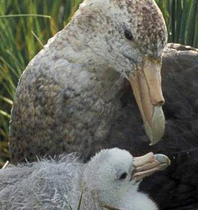 | Southern Giant Petrel (Macronectes giganteus).  |
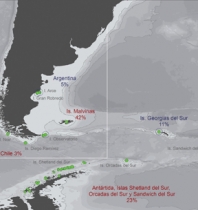 |
Regional Nesting Sites of the Southern Giant Petrel (Macronectes giganteus).
References. Green dots: colonies and the percentage of the world population that each area represents. Blue text: populations for which the Atlas provides distribution data. Red text: populations for which there are no data. Blue circle: colonies of origin of individuals studied.
| © Graham Robertson |
 |
Nesting sites |
 Principal feeding areas Principal feeding areas |
Southern Giant Petrels from the Argentine coast use coastal and pelagic areas of the continental shelf, the slope, around the colonies in the north of San Jorge Gulf and Staten Island, and waters opposite Río de la Plata in the north of the target area.
Data on 22 adults and 11 juveniles of both sexes from the colonies on the Patagonian Coast: Gran Robredo, Arce and Observatorio Island. Period: January-December.
Dataholder: F. Quintana.
 | 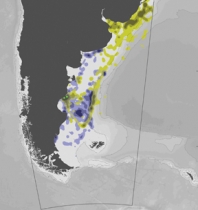 Autumn-Winter (Patagonia) Autumn-Winter (Patagonia) |
Although there are areas of shared use (slope areas opposite the San Jorge Gulf and coastal waters close to the colonies), juveniles of the Southern Giant Petrels more widely dispersed than adults and principally use areas to the north of the Patagonian Sea (Río de la Plata, Uruguay and south of Brazil).
Data on 11 juveniles (period: April-July) and 6 adults (period: April-September) of both sexes from Arce and Gran Robredo islands, northern Patagonia.
Dataholder: F. Quintana.
 Summer (Patagonia) Summer (Patagonia) |
The data reveal a certain degree of sexual segregation in the use of foraging areas by the Southern Giant Petrels from the Argentine coast. Females are basically pelagic, while males feed principally in coastal waters near sea lion, elephant seal and penguin colonies.
Data on adult males and females from the Patagonian colonies on Arce Island (4 males and 1 female), Gran Robredo (1 male and 1 female) and Observatorio Island (1 male and 6 females). Period: January-March.
Dataholder: F. Quintana.
 | 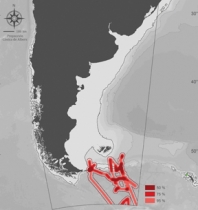 Spring-Summer (S. Georgia) Spring-Summer (S. Georgia) |
Only 2 adult females of Southern Giant Petrel, from the 11 individuals studied from South Georgia, during the incubation period (spring) moved into the sub-Antarctic waters of the Patagonian Sea to feed.
Data on 2 adult females from South Georgia. Period: November-January.
Dataholders: J. Croxall, P. Trathan, R. Phillips and J. González-Solís.
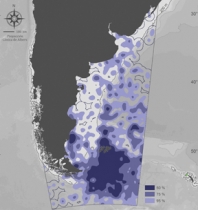 Autumn-Winter (S. Georgia) Autumn-Winter (S. Georgia) |
Southern Giant Petrel adults from South Georgia feed further away from the colonies at the end of the breeding season. The area of intense use continues however to be in the south of the Patagonian Sea, the vecinity of the Malvinas Islands and some coastal areas near Puerto Santa Cruz and Río Grande (Tierra del Fuego).
Data (obtained with geolocators) on 15 adults (12 females and 3 males) from South Georgia. Period: April-September.
Dataholders: J. Croxall, P. Trathan, R. Phillips and J. González-Solís.
 | |
|
 |
Southern Giant Petrel
Macronectes giganteus
Regional Nesting Sites: The species breeds throughout the southern oceans. On mainland Argentina there are colonies in northern Patagonia and on Staten Island. The species also nests on the Malvinas Islands, south of Chile, the Antarctic Peninsula and most of sub-Antarctic islands. Diet: Adults feed principally on carrion (penguins and remains of marine mammals). However, squid, fish and crustaceans are common features in the diet. Rubbish and discards from fishing vessels are another important element. World breeding population: Estimated at 46,000 pairs. Conservation Status: Near threatened (IUCN, 2008). Main threats: Incidental mortality in long-line and trawl fishing.

|

